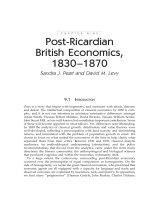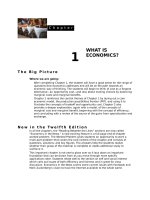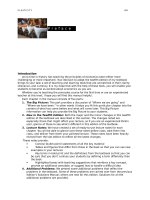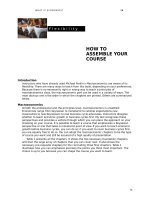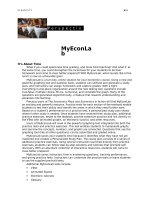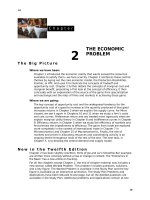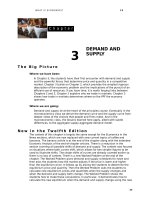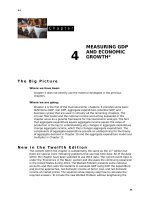Answers to review quizzes marcroeconomics 12e parkin chapter 9
Bạn đang xem bản rút gọn của tài liệu. Xem và tải ngay bản đầy đủ của tài liệu tại đây (272.59 KB, 16 trang )
W H AT I S E C O N O M I C S ?
153
9
THE EXCHANGE
RATE AND THE
BALANCE OF
PAYMENTS**
Answers to the Review Quizzes
Page 256 (page 664 in Economics)
1.
What are the influences on the demand for U.S. dollars in the foreign
exchange market?
The demand for U.S. dollars depends on four main factors: the exchange rate, the
world demand for U.S. exports, the interest rate in the United State and other
countries, and the expected future exchange rate.
2.
What are the influences on the supply of U.S. dollars in the foreign exchange
market?
The supply of U.S. dollars depends on four main factors: the exchange rate, the
U.S. demand for imports, the interest rate in the United States and other countries,
and the expected future exchange rate.
3.
How is the equilibrium exchange rate determined?
The equilibrium exchange rate is the exchange rate that sets the quantity of U.S.
dollars demanded equal to the quantity of U.S. dollars supplied. At the equilibrium
exchange rate there is neither a shortage nor a surplus of U.S. dollars.
4.
What happens if there is a shortage or a surplus of U.S. dollars in the foreign
exchange market?
If there is a shortage of U.S. dollars, the quantity of U.S. dollars demanded exceeds
the quantity supplied. As long as there is a shortage, this upward pressure on the
price automatically forces the price higher to its equilibrium.
If there is a surplus of U.S. dollars, the quantity of U.S. dollars demanded is less
than the quantity supplied. As long as there is a surplus, this downward pressure
on the price automatically forces the price lower to its equilibrium.
5.
What makes the demand for U.S. dollars change?
Three factors change the demand for U.S. dollars: the world demand for U.S.
exports, the interest rate in the United States and other countries, and the
expected future exchange rate. If world demand for U.S. exports increases, the
demand for U.S. dollars increases. If the interest rate in the United States rises
relative to interest rates in other countries, the demand for U.S. dollars increases.
153
154
And if the expected future exchange rate rises, the demand for U.S. dollars
increases.
6.
What makes the supply of U.S. dollars change?
Three factors change the supply of U.S. dollars: U.S. demand for imports, the
interest rate in the United States and other countries, and the expected future
exchange rate. If U.S. demand for imports increases, the supply of U.S. dollars
increases. If the interest rate in the United States falls relative to interest rates in
other countries, the supply of U.S. dollars increases. And if the expected future
exchange rate falls, the supply of U.S. dollars increases.
7.
What makes the U.S. dollar exchange rate fluctuate?
Changes in the demand for U.S. dollars and the supply of U.S. dollars lead to
fluctuations in the U.S. dollar exchange rate. Because the demand for dollars and
the supply of dollars generally change at the same time and in opposite directions,
exchange rate fluctuations are frequently large.
Page 260 (page 668 in Economics)
1.
What is arbitrage and what are its effects in the foreign exchange market?
Arbitrage is seeking to profit by buying in one market and selling for a higher price
in another market. Arbitrage has several effects:
2.
Law of one price: At any one time, an exchange rate is the same in all
markets.
No round-trip profit: It is impossible to make a profit by using currency A to
buy currency B and then selling currency B to buy currency A. It is
impossible to make a profit if even longer chains of currency are used.
Interest rate parity: For risk-free transactions, the rate of return earned by a
unit of currency is the same in different nations.
Purchasing power parity: Purchasing power parity occurs when a unit of
money buys the same amount of goods and services in different nations.
What is interest rate parity and what happens when this condition doesn’t
hold?
Interest rate parity occurs when, for risk-free transactions, the rate of return
earned by a unit of currency is the same in different nations. If the rate of return
for the U.S. dollar is higher than that for, say, the Japanese yen, interest rate parity
does not hold. In this case people will expect the value of the dollar to fall against
the yen (that is, the U.S. dollar is expected to depreciate over time) so that interest
rate parity is restored because the rate of return earned by a unit of currency is the
same in both nations.
3
What makes an exchange rate hard to predict?
The exchange rate depends on the expected future exchange rate. The expected
future is volatile. For example, the U.S. expected future exchange rate changes
when news occurs that changes the future demand and/or supply of U.S. dollars.
Consequently the current demand and supply of U.S. dollars changes, thereby
changing the U.S. exchange rate.
4.
What is purchasing power parity and what happens when this condition
doesn’t hold?
Purchasing power parity means equal value of money. If prices of goods and
services are higher in the United States than the (exchange rate adjusted) prices of
goods and services in, say, Japan, purchasing power parity does not occur because
a unit of currency buys less in the United States than in Japan. The demand for
154
W H AT I S E C O N O M I C S ?
155
U.S. dollars decreases and the supply of U.S. dollars increases so that the value of
the dollar falls against the yen to restore purchasing power parity.
5.
What determines the real exchange rate and the nominal exchange rate in
the short run?
The real exchange between the United States and Japan, RER, equals E P/P*
where P is the U.S. price level, P* is the Japanese price level, and E is the nominal
exchange rate in yen per dollar. In the short run, changes in the nominal exchange
rate bring an equal change in the real exchange rate because the price levels in
Japan and the United States do not adjust instantly to a change in the nominal
exchange rate.
In the short run, the nominal U.S. exchange rate is determined in the foreign
exchange market as the exchange rate that sets the quantity of U.S. dollars
demanded equal to the quantity of U.S. dollars supplied.
6.
What determines the real exchange rate and the nominal exchange rate in
the long run?
In the long run, the real exchange rate is determined by demand and supply in the
goods market. Identical goods in the United States and Japan sell for the same
price once adjusted for the (nominal) exchange rate. The relative prices of goods
that are not identical are determined by the supply and demand for them and so
the relative price levels in different countries are determined by supply and
demand. These relative price levels determine the real exchange rate.
In the long run, changes in the real exchange rate and changes in the price levels
change the nominal exchange rate. In the long run, the price level is determined
by the quantity of money. So changes in the U.S. or the Japanese quantity of
money change the price level and also bring an offsetting change in the nominal
exchange rate.
Page 263 (page 671 in Economics)
1.
What is a flexible exchange rate and how does it work?
A flexible exchange rate policy is an exchange rate that is determined by demand
and supply with no direct intervention in the foreign exchange market by the
central bank. In this arrangement, the forces of supply and demand with no direct
central bank intervention are the only factors that influence the exchange rate.
2.
What is a fixed exchange rate and how is its value fixed?
A fixed exchange rate policy is an exchange rate that is pegged at a value decided
by the government or central bank. The central bank directly intervenes in the
foreign exchange market to block the unregulated forces of supply and demand
from changing the exchange rate away from its pegged value. For instance, if a
central bank wanted to hold the exchange rate steady in the presence of
diminished demand for its currency, the central bank props up demand by buying
its currency in the foreign exchange market to keep the exchange rate from falling.
If the demand for its currency increases, the central bank increases the supply by
selling its currency and keeps the exchange rate from rising.
3.
What is a crawling peg and how does it work?
A crawling peg exchange rate policy selects a target path for the exchange rate
and then uses direct central bank intervention in the foreign exchange market to
achieve that path. A crawling peg works like a fixed exchange rate except that the
central bank changes the target value of the exchange rate in accord with its
target path.
4.
How has China operated in the foreign exchange market, why, and with what
effect?
155
156
From 1997 until 2005, the People’s Bank of China fixed the Chinese yuan exchange
rate. Over this time, the demand for the yuan increased, so the People’s Bank of
China supplied additional yuan to keep the exchange rate constant. By supplying
yuan, the People’s Bank acquired large amounts of foreign currency. In addition, by
fixing its exchange rate China essentially pegged its inflation rate to equal the U.S.
inflation rate. Since 2005 the yuan has been allowed to appreciate slightly as the
People’s Bank moved to a crawling peg exchange rate policy. The exchange rate
has not been allowed to change much, so over the long run the Chinese inflation
rate remains closely tied to U.S. inflation.
Page 269 (page 677 in Economics)
1.
What are the transactions that the balance of payments accounts record?
The current account records payments for imports of goods and services from
abroad, receipts from exports of goods and services sold abroad, net interest
income paid abroad, and net transfers abroad (such as foreign aid payments). The
capital and financial account records foreign investment in the U.S. minus U.S.
investment abroad. Any statistical discrepancy is also recorded in the capital
account. The official settlements account records the change in U.S. official
reserves.
2.
Is the United States a net borrower or a net lender? Is it a debtor or a creditor
nation?
The United States is a net borrower and is a debtor nation.
3.
How are net exports and the government sector balance linked?
Net exports is the value of exports of goods and services minus the value of
imports of goods and services. Net exports is equal to the sum of government
sector surplus or deficit plus the private sector surplus or deficit. The government
sector balance is equal to net taxes minus government expenditure on goods and
services. If the government sector balance is negative, then the government sector
has a deficit, that is, a budget deficit. Because net exports equals the sum of the
government sector balance plus private sector balance, if the government budget
deficit increases and the private sector balance does not change, the value of net
exports becomes more negative.
156
Answers to the Study Plan Problems and
Applications
Use the following data to work Problems 1 to 3.
The U.S. dollar exchange rate increased from $0.96 Canadian in June 2011 to $1.03
Canadian in June 2012, and it decreased from 81 Japanese yen in June 2011 to 78
yen in June 2012.
1.
Did the U.S. dollar appreciate or depreciate against the Canadian dollar? Did
the U.S. dollar appreciate or depreciate against the yen?
The U.S. dollar appreciated against the Canadian dollar and it depreciated against
the yen.
2.
What was the value of the Canadian dollar in terms of U.S. dollars in June
2011 and June 2012? Did the Canadian dollar appreciate or depreciate
against the U.S. dollar over the year June 2011 to June 2012?
One Canadian dollar was worth 104 U.S. cents in June 2011 and 97 U.S. cents in
June 2012. The Canadian dollar depreciated against the U.S. dollar.
3.
What was the value of 100 yen in terms of U.S. dollars in June 2011 and June
2012? Did the yen appreciate or depreciate against the U.S. dollar over the
year June 2011 to June 2012?
One hundred yen was worth 123 U.S. cents in June 2011 and 128 U.S. cents in June
2012. The yen appreciated against the U.S. dollar.
4.
On March 30, 2012, the U.S. dollar was trading at 82 yen per U.S. dollar on
the foreign exchange market. On August 30, 2012, the U.S. dollar was trading
at 79 yen per U.S. dollar.
a. What events in the foreign exchange market could have brought this fall in
the value of the U.S. dollar?
The fall in the U.S. exchange rate is the result of a decrease in the demand for U.S.
dollars and/or an increase in the supply of U.S. dollars. Factors that decrease the
demand for U.S. dollars include a decrease in the Japanese demand for U.S.
exports; a fall in the U.S. interest rate relative to the Japanese interest rate; and, a
fall in the expected future exchange rate. Factors that increase the supply of U.S.
dollars include an increase in the U.S. demand for Japanese imports; a fall in the
U.S. interest rate relative to the Japanese interest rate; and, a fall in the expected
future exchange rate.
b. Did the events you’ve described change the demand for U.S. dollars, the
supply of U.S. dollars, or both demand and supply in the foreign exchange
market?
A decrease in the Japanese demand for U.S. exports leads to only a decrease in the
demand for U.S. dollars. An increase in the U.S. demand for Japanese imports
leads only to an increase in the supply of U.S. dollars. The other factors, a fall in
the U.S. interest rate relative to the Japanese interest rate and a fall in the expected
future exchange rate, change both the demand for U.S. dollars and the supply of U.S.
dollars.
T H E E X C H A N G E R AT E A N D T H E B A L A N C E O F PAY M E N T S
5.
Colombia is the world’s biggest producer of roses. The global demand for
roses increases and at the same time Colombia’s central bank increases the
interest rate. In the foreign exchange market for Colombian pesos, what
happens to
a. The demand for pesos?
The demand for the peso increases because the Colombian interest rate
differential increases and because the demand for Colombia’s export, roses,
increases.
b. The supply of pesos?
The supply of the pesos decreases because the Colombian interest rate differential
increases.
c. The quantity of pesos demanded?
The Colombian exchange rate rises. The rise in the exchange rate creates a
movement upward along the new demand curve, so along the new demand curve
for pesos, the quantity of pesos demanded decreases.
d. The quantity of pesos supplied?
The Colombian exchange rate rises. The rise in the exchange rate creates a
movement upward along the new supply curve, so along the new supply curve of
pesos, the quantity of pesos supplied increases.
e. The peso-U.S. dollar exchange rate?
The U.S. exchange rate depreciates (and the Columbian exchange rate
appreciates) because the demand for Colombian pesos increases and the supply
decreases.
6.
If a euro deposit in a bank in France earns interest of 4 percent a year and a
yen deposit in Japan earns 0.5 percent a year, other things remaining the
same and adjusted for risk, what is the exchange rate expectation of the
Japanese yen?
For interest rate parity to hold, the Japanese yen must be expected to appreciate
by the difference in the interest rates. So the Japanese yen must be expected to
appreciate by 4.0 percent minus 0.5 percent, or 3.5 percent.
7.
The U.K. pound is trading at 1.50 U.S. dollars per U.K. pound and purchasing
power parity holds. The U.S. interest rate is 1 percent a year and the U.K.
interest rate is 3 percent a year.
a. Calculate the U.S. interest rate differential.
The U.S. interest rate differential equals 1 percent minus 3 percent, or 2 percent
per year.
b. What is the U.K. pound expected to be worth in terms of U.S. dollars one
year from now?
For interest rate parity to hold, the U.K. pound must be expected to depreciate 2
percent per year. Therefore next year the U.K. pound is expected to be equal to
0.98 1.50 U.S. dollars per U.K. pound, which is 1.47 U.S. dollars per U.K. pound.
c. Which country more likely has the lower inflation rate? How can you tell?
Because the U.K. pound is expected to depreciate, the United Kingdom likely has
the higher inflation rate, which means that the United States is expected to have
the lower inflation rate.
115
116
8.
CHAPTER 9
The U.S. price level is 115, the Japanese price level is 92, and the real
exchange rate is 98.75 Japanese real GDP per unit of U.S. real GDP. What is
the nominal exchange rate?
The real exchange rate equals (E × P)/P* in which E is the nominal exchange rate,
P is the U.S. price level, and P* is the Japanese price level. Rearranging this
formula gives E = (real exchange rate × P*)/P. Using the rearranged formula, the
nominal exchange rate equals (98.75 × 92)/115 = 79.0 yen per dollar.
9.
With the strengthening of the yen against the U.S. dollar in 2012, Japan’s
central bank did not take any action. A Japanese politician called on the
central bank to take actions to weaken the yen, saying it will help exporters in
the short run and have no long-run effects.
a. What is Japan’s current exchange rate policy?
Japan’s current exchange rate policy is a flexible exchange.
b. What does the politician want the exchange rate policy to be in the short
run? Why would such a policy have no effect on the exchange rate in the
long run?
The politician wants the exchange rate to be a crawling peg by lowering it over a
period of time. This policy has no effect on the exchange rate in the long run
because in the long run the real exchange rate is determined by supply and
demand for the nation’s goods. In addition, the nominal exchange rate adjusts to
make the ratio of the nations’ price levels equal to the real exchange rate.
T H E E X C H A N G E R AT E A N D T H E B A L A N C E O F PAY M E N T S
10.
The table gives some information
about the U.S. international
transactions.
a. Calculate the balance on the three
balance of payments accounts.
Item
Imports of goods and
services
Foreign investment in
the
United States
Exports of goods and
services
U.S. investment abroad
Net interest income
Net transfers
Statistical discrepancy
Billions of
U.S.
dollars
2,215
The current account balance equals
1,408
exports of goods and services
($1,754 billion) minus imports of
goods and services ($2,215 billion)
1,754
plus net interest income ($167
billion) plus net transfers ($142
1,200
billion). So the current account
167
balance is $436 billion.
−142
The capital and financial account
231
balance equals foreign investment in
the United States ($1,408 billion)
minus U.S. investment abroad ($1,200 billion) plus the statistical discrepancy
($231 billion). So the capital and financial account balance is $439 billion.
The official settlements account balance equals current account balance ($436
billion) capital and financial account balance ($439 billion). So the official
settlements account balance is −$3 billion. Because the official settlements
account is negative, U.S. official reserves are increasing.
b. Was the United States a net borrower or a net lender? Explain your answer.
The United States was a net borrower because foreign investment in the United
States exceeded U.S. investment abroad.
117
118
CHAPTER 9
Answers to Additional Problems and Applications
11.
Suppose that yesterday, the U.S. dollar was trading on the foreign exchange
market at 0.75 euros per U.S. dollar and today the U.S. dollar is trading at
0.80 euros per U.S. dollar. Which of the two currencies (the U.S. dollar or the
euro) has appreciated and which has depreciated today?
The U.S. dollar appreciated because its exchange rate rose. The euro depreciated
because its exchange rate fell (from 1.33 U.S. dollars per euro to 1.25 U.S. dollars
per euro).
12.
Suppose that the exchange rate rose from 80 yen per U.S. dollar to 90 yen
per U.S. dollar. What is the effect of this change on the quantity of U.S. dollars
that people plan to sell in the foreign exchange market?
The rise in the exchange rate increases the quantity of U.S. dollars that people
plan to sell in the foreign exchange market.
13.
Suppose that the exchange rate for the Mexican peso fell from 15 pesos per
U.S. dollar to 10 pesos per U.S. dollar. What is the effect of this change on the
quantity of U.S. dollars that people plan to buy in the foreign exchange
market?
The fall in the exchange rate increases the quantity of U.S. dollars that people plan
to buy in the foreign exchange market.
14.
Today’s exchange rate between the Lebanese pound and the U.S. dollar is
1,500 LBP per dollar and the central bank of Lebanon is buying U.S. dollars in
the foreign exchange market. If the central bank of Lebanon did not purchase
U.S. dollars would there be excess demand or excess supply of U.S. dollars in
the foreign exchange market? Would the exchange rate remain at 1,500 LBP
per U.S. dollar? If not, which currency would appreciate?
In the absence of the purchases by the central bank of Lebanon, there would be an
excess supply of U.S. dollars in the foreign exchange market. Without these
purchases, the exchange rate would fall from 1,500 LBP per dollar to something
lower. The Lebanese pound would appreciate (and the U.S. dollar would
depreciate).
15.
On October 25, 2000, the exchange rate was 0.8307 U.S. dollar per euro. It
increased to 1.588 U.S. dollars per euro on July 16, 2008, and then decreased
to 1.0557 U.S. dollar per euro on March 16, 2015. If the euro is expected to
bounce back to its 2008 exchange rate, explain how this would affect the
demand for and the supply of euros in the foreign exchange market?
If the euro is expected to bounce back to its 2008 exchange rate, it raises the
expected profit from holding euros and thereby affects both the demand for and
the supply of euros. The rise in the expected profit from holding euros increases
the demand for euros because people would rather hold more profitable
currencies. But the supply of euros will decrease.
16.
The exchange rate changed from 1.0557 U.S. dollar per euro on July 16, 2008
to 1.588 U.S. dollars per euro on March 16, 2015. Which factors caused these
changes in the exchange rate? Which factors would change both demand and
supply?
The factors that influenced the exchange rate for the euro include (i) the Eurozone
debt crisis which caused the investors to invest less in Eurozone sovereign bonds.
The investors preferred to invest in bonds of other countries such as the U.S. (ii)
The European Central Bank kept interest rates low and started pumping euros into
the money market to boost the economy (iii) The demand for U.S. exports and
T H E E X C H A N G E R AT E A N D T H E B A L A N C E O F PAY M E N T S
European imports dropped because of the U.S. subprime mortgage crisis that
caused a recession in the U.S. and the Eurozone. Because of these reasons, there is
a high supply of and a lower demand for euros, pushing the euro down. Changes in
the interest rate differential and expected future exchange rate between the U.S.
and the Eurozone can change both demand and supply.
17.
Australia produces natural resources (coal, iron ore, natural gas, and others),
the demand for which has increased rapidly as China and other emerging
economies expand.
a. Explain how growth in the demand for Australia’s natural resources would
affect the demand for Australian dollars in the foreign exchange market.
The growth in demand for Australia’s natural resources increases the demand for
Australian dollars.
b. Explain how the supply of Australian
dollars would change.
Absent any change in the expected
future exchange rate, the supply of
Australian dollars does not change (there
is a change in the quantity supplied).
c. Explain how the value of the Australian
dollar would change.
The increase in demand for Australian
dollars raises the value of the Australian
dollar.
d. Illustrate your answer with a graphical
analysis.
Figure 9.1 illustrates the effect of the
increase in demand for Australian
dollars. The demand curve for Australian
dollars shifts rightward, from D0 to D1.
The supply curve does not shift. The
exchange rate rises from 90 yen per Australian dollar to 95 yen per Australian
dollar.
Use the following news clip to work Problems 18 and 19.
Indian Entrepreneur Seeks Opportunities
Rahul Reddy, an Indian real estate entrepreneur, believes that “The United States
is good for speculative higher-risk investments.” He profited from earlier
investment in Australia and a strong Australian dollar provided him with the funds
to enter the U.S. real estate market at prices that he believed “we will probably not
see for a long time.” He said, “The United States is an economic powerhouse that I
think will recover, and if the exchange rate goes back to what it was a few years
ago, we will benefit.”
Based on an article in Forbes, July 10, 2008
18.
Explain why Mr. Reddy is investing in the U.S. real estate market.
At the time of the news article, the U.S. dollar had depreciated. The short-run effect
of this depreciation was to make U.S. goods and services and U.S. properties less
expensive for foreigners. Mr. Reddy, among others, was trying to take advantage of
the lower price by purchasing investment properties and development
opportunities in the United States.
119
120
19.
CHAPTER 9
Explain what would happen if the speculation made by Mr. Reddy became
widespread. Would expectations become self-fulfilling?
Mr. Reddy’s actions increase the demand for U.S. dollars. If others take similar
actions, the demand for U.S. dollars increases. If U.S. residents also begin to
believe that buying U.S. investment properties offers a profitable opportunity, the
supply of U.S. dollars decreases as U.S. residents purchase U.S. properties rather
than foreign properties. In addition, Mr. Reddy is expecting that the dollar will
appreciate back to its previous level. If others have the same expectation, once
again the demand for dollars increases and the supply of dollars decreases. On
both counts, the dollar appreciates. This change in the exchange rate resembles a
self-fulfilling prophecy because market participants expect the dollar to appreciate
and, as a result, it does so. Of course, the fundamental reason for the change is
the shift in people’s beliefs.
Use the following information to work Problems 20 and 21.
Brazil’s Overvalued Real
The Brazilian real has appreciated 33 percent against the U.S. dollar and has
pushed up the price of a Big Mac in Sao Paulo to $4.60, higher than the New York
price of $3.99. Despite Brazil’s interest rate being at 8.75 percent a year compared
to the U.S. interest rate at near zero, foreign funds flowing into Brazil surged in
October.
Source: Bloomberg News, October 27, 2009
20.
Does purchasing power parity hold? If not, does PPP predict that the Brazilian
real will appreciate or depreciate against the U.S. dollar? Explain.
Purchasing power parity (PPP) does not hold because a Big Mac is significantly
more expensive in Brazil than in New York. PPP predicts that the Brazilian real will
depreciate against the U.S. dollar. Depreciation will reduce the number of U.S.
dollars it takes to buy a Brazilian real and thereby decrease the number of U.S,
dollars it takes to purchase a Big Mac in Brazil back to equality with the number of
dollars it takes to purchase a Big Mac in New York.
21.
Does interest rate parity hold? If not, why not? Will the Brazilian real
appreciate further or depreciate against the U.S. dollar if the Fed raises the
interest rate while the Brazilian interest rate remains at 8.75 percent a year?
Interest rate parity holds. The difference in the interest rates is offset by the
expected depreciation of the Brazilian real, so the real is expected to depreciate by
8.75 percent a year. If the Fed raises the U.S. interest rate, interest rate parity will
continue to hold. Because the U.S. interest rate is now higher, the real depreciates.
The higher U.S. interest rate means that the U.S. interest rate differential
increases. The demand for dollars increases and the supply decreases, so the
dollar immediately appreciates which means the real immediately depreciates.
The real is still expected to depreciate in the future, but the expected future
depreciation is less than 8.75 percent a year because the interest rate differential
is smaller.
T H E E X C H A N G E R AT E A N D T H E B A L A N C E O F PAY M E N T S
22.
When the Chips Are Down
The Economist magazine uses the price of a Big Mac to determine whether a
currency is undervalued or overvalued. In July 2012, the price of a Big Mac
was $4.33 in New York, 15.65 yuan in Beijing, and 6.50 Swiss francs in
Geneva. The exchanges rates were 6.37 yuan per U.S. dollar and 0.98 Swiss
francs per U.S. dollar.
Source: The Economist, July 25, 2012
a. Was the yuan undervalued or overvalued relative to purchasing power
parity?
Changing the price of a Big Mac in China into U.S. prices shows that the Chinese
Big Mac has a dollar price of 15.65 yuan ÷ 6.37 yuan per dollar which is $2.46.
The yuan was undervalued relative to purchasing power parity.
b. Was the Swiss franc undervalued or overvalued relative to purchasing power
parity?
Changing the price of a Big Mac in Switzerland into U.S. prices shows that the
Swiss Big Mac has a dollar price of 6.50 francs ÷ 0.98 francs per dollar which is
$6.63. The Swiss franc was overvalued relative to purchasing power parity.
c. Do you think the price of a Big Mac in different countries provides a valid
test of purchasing power parity?
The price of a Big Mac is the price of only one good. Purchasing power parity
applies to national price levels not to the price of an individual good. Using an
individual good means that local supply and demand conditions might lead the
price to diverge from purchasing power parity.
121
122
CHAPTER 9
Use the following news clip to work Problems 23 to 25.
U.S. Declines to Cite China as Currency Manipulator
In 2007, the U.S. trade deficit with China hit an all-time high of $256.3 billion, the
largest deficit ever recorded with a single country. Chinese currency, the yuan, has
risen in value by 18.4 percent against the U.S. dollar since the Chinese government
loosened its currency system in July 2005. However, U.S. manufacturers contend
the yuan is still undervalued by as much as 40 percent, making Chinese products
more competitive in this country and U.S. goods more expensive in China. China
buys U.S. dollar-denominated securities to maintain the value of the yuan in terms
of the U.S. dollar.
Source: MSN, May 15, 2008
23.
What was the exchange rate policy adopted by China until July 2005? Explain
how it worked. Draw a graph to illustrate your answer.
The actions in the foreign exchange
market of the People’s Bank allowed
China to maintain a fixed exchange
rate with the United States. If, at the
fixed exchange, there was surplus of
dollars (which implies there is a
shortage of yuan), the People’s Bank
bought the dollars using yuan.
Without this action by the People’s
Bank, the surplus of dollars would
have depreciated the dollar and
appreciated the yuan; with this action
by the People’s Bank, the exchange
rate stayed fixed.
Figure 9.2 shows the foreign exchange
market. At the fixed exchange of 7.00
yuan per dollar, there is a surplus of
$0.2 trillion U.S. dollars. If the market
is allowed to reach its equilibrium
exchange rate, the dollar would depreciate to 5.00 yuan per dollar, which means
that the yuan would appreciate. But the People’s Bank purchased the $0.2 trillion
U.S. dollar surplus and thereby kept the exchange rate pegged at 7.00 yuan per
dollar. By fixing its exchange rate in order to keep the yuan from appreciating, the
People’s Bank accumulated U.S. dollars.
24.
What was the exchange rate policy adopted by China after July 2005? Explain
how it works.
After July 2005 China has not allowed a truly flexible exchange rate. Instead China
uses a crawling peg policy, in which the exchange rate is allowed to make small
changes.
25.
Explain how fixed and crawling peg exchange rates can be used to
manipulate trade balances in the short run, but not the long run.
Changes in fixed and crawling peg exchange rates can affect the trade balance in
the short run because these changes affect the relative price of the domesticallyproduced good and the foreign good. But changes in fixed and crawling peg
exchange rates cannot affect the trade balance in the long run because the trade
balance is (ultimately) determined by the real exchange rate. In the long run, the
price levels will adjust to create a real exchange rate that balances trade.
T H E E X C H A N G E R AT E A N D T H E B A L A N C E O F PAY M E N T S
26.
Aussie Dollar Hit by Interest Rate Talk
The Australian dollar fell against the U.S. dollar to its lowest value in the past
two weeks. The CPI inflation rate was reported to be generally as expected,
but not high enough to justify expectations for an aggressive interest rate rise
by Australia’s central bank next week.
Source: Reuters, October 28, 2009
a. What is Australia’s exchange rate policy? Explain why expectations about
the Australian interest rate lowered the value of the Australian dollar against
the U.S. dollar.
Because the Australian dollar was allowed to fall, the central bank must be
following a flexible exchange rate policy. When Australia’s central bank raises the
interest rate, the demand for Australian dollars increases and the supply
decreases, so the Australian exchange rate rises. Before the report, traders
expected the Australian central bank would raise the interest rate at some point in
the future, which meant that the (expected) future exchange rate would rise. But
the report indicated that the interest rate would not rise, which thereby decreased
the expected future exchange rate. The fall in the expected future exchange rate
decreases the demand for Australian dollars and increases the supply of
Australian dollars, thereby lowering the Australian exchange rate.
b. To avoid the fall in the value of the Australian dollar against the U.S. dollar,
what action could the central bank of Australia have taken? Would such an
action signal a change in Australia’s exchange rate policy?
To avoid a fall in the Australian exchange rate, the central bank of Australia could
have entered the foreign exchange market to purchase Australian dollars or it
could have immediately raised the exchange rate. If the central bank prevented
100 percent of the change in the exchange rate, then the central bank would be
pegging the exchange rate. If it prevented some of the change in the exchange
rate, then the central bank might be allowing the exchange rate to crawl. In either
case, however, the exchange rate regime would no longer be flexible.
Use the table to work Problems 27 and
28. The table gives some data about the
U.K. economy:
27.
Calculate the private sector and
government sector balances.
Item
Consumption
expenditure
Exports of goods and
services
Government expenditure
Net taxes
Investment
Saving
The private sector balance equals
saving (£162 billion) minus
investment (£181 billion), which is
£19 billion.
The government sector balance is
equal to net taxes (£217 billion)
minus government expenditures on
goods and services (£230 billion), which is £13 billion.
28.
Billions of
U.K.
pounds
721
277
230
217
181
162
What is the relationship between the government sector balance and net
exports?
The government sector balance plus the private sector balance equals net exports.
Therefore the net exports equals the private sector balance (£19 billion) plus the
government sector balance (£13 billion), which is £32 billion. The U.K. had a net
export deficit of £32 billion.
123
124
CHAPTER 9
Economics in the News
29.
After you have studied Economics in the News on pp. 270–271 (678–679 in
Economics), answer the following questions.
a. What happened to the foreign exchange value of the U.S. dollar in July and
August 2014?
The dollar rose against the euro, the pound, and the yen.
b. What could the Fed have done to stop the rise in the dollar?
The Fed could have sold U.S. dollars in the foreign exchange market by purchasing
foreign reserves. The Fed’s actions would have increased the supply of dollars and
thereby lessened the dollar’s rise.
c. What could the European Central Bank have done that might have stopped
the fall in the Euro?
The European Central Bank could have purchased euros by selling foreign
reserves. The European Central Bank’s actions would have increased the demand
for euros and thereby lessened the euro’s fall.
d. What can you infer about the changes in U.K. pound–euro exchange rate
during July and August 2014? Can you think of a reason for the behavior of
that exchange rate?
Stating on Jul 2, the U.K. pound and the European euro depreciated an almost
identical amount against the U.S. dollar. Therefore there was very little to no
change in the U.K. pound-euro exchange rate. This exchange might have remained
constant because there was no change in the expected future U.K. pound-euro
exchange rate because there was no change in the future expected U.K or
European interest rates and other relevant U.K. or and European factors. The two
exchange rates depreciated against the U.S. dollar because there were changes in
the future expected U.S. interest rate and/or other relevant factors.
f.
If the dollar continues its upward path against the euro, what do you predict
will be the consequences for U.S. and European relative inflation rates?
Purchasing power parity implies that if the U.S. dollar continues to rise, it is likely
that the U.S. inflation rate will fall relative to European inflation. Similarly, if the
euro continues to fall, it is likely that the European inflation rate will rise relative to
U.S. inflation.
T H E E X C H A N G E R AT E A N D T H E B A L A N C E O F PAY M E N T S
125
